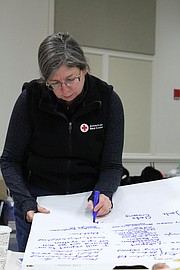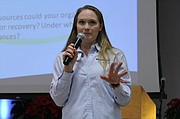A table of first responders, representatives from area faith groups and the Reston Hospital Center discuss how their organizations could help during the recovery phase of a disaster situation. Photo by Fallon Forbush.
More than 185 people registered to learn about forming a Community Resiliency Group for the Hunter Mill District, which would be activated to aid in the local area’s recovery after a disaster.
Volunteer Fairfax and the Fairfax County Office of Emergency Management explained the county’s new concept to participants during a seminar at the Heritage Fellowship Church on Fox Mill Road in Reston on Tuesday, Jan. 10.
“The complex terrorism stuff, it’s out there,” Roy Shrout, the deputy coordinator of Fairfax County’s Office of Emergency Management, said during the seminar. “You know it is, it’s everywhere. We have people here in Fairfax. We know they’re here. You just have to be alert. You have to make sure you’re ready to go.”
POSSIBLE DISASTERS can range from terrorist attacks to weather events like storms and floods, to earthquakes, power outages and chemical spills.
Each magisterial district within the county will have its own Community Resiliency Group once the Fairfax County Community Collaboration for Disaster Resiliency Pilot Program is completely rolled out.
The program is funded from a grant from the U.S. Department of Homeland Security’s Urban Area Security Initiatives Program and CRGs have already been set up in the Mason, Braddock, Sully, Dranesville, Lee and Mount Vernon districts.
“This allows more of the community to be more involved if something happens and allows the community to find out what they can do for each other,” says Shrout. “We’re getting capabilities that we didn’t know existed.”
As part of the CRG, leaders must sign their organizations up to participate through Volunteer Fairfax. The participant form to sign-up requires participants to list resources and capabilities that may be available during a recovery effort, including transportation, generators, food, clothing, storage, tools, commercial refrigerators, commercial washers and dryers, volunteers, translators, communication networks, parking lots, counseling services and more.
Participant’s capabilities are then added into a database that is managed by Volunteer Fairfax to use to help find volunteers and resources after a disaster occurs.
“We are asking leaders to fill out the participant form,” Emily Swenson, the chief operating officer of Volunteer Fairfax, said during the seminar. “CRGs are really trying to harness and understand what the capabilities and resources are that your organizations have already that might be able to be brought to the table should there be an emergency and need for them.”
Once an organization is signed-up, participation is always voluntary. But for organizations that already assist those in need, involvement in a CRG could provide additional protection.
“If you open up your facility without Fairfax County coming to you first, then you assume whatever liability that you have at that point in time,” Shrout said during the seminar. “If Fairfax County comes to you … then any issues that you may have at that point in time will be covered by Fairfax County.”
However, the county’s coverage is secondary to any other insurance a volunteer or volunteer organization may have already.
ON THURSDAY, FEB. 9, the Hunter Mill District CRG will meet again at the Heritage Fellowship Church on Fox Mill Road in Reston at 6 p.m. to practice how it would respond to a local snow disaster.
This will be done by conducting a tabletop exercise that has been developed by the Federal Emergency Management Agency National Exercise Program.
Community leaders in the Hunter Mill District are encouraged to get involved.



